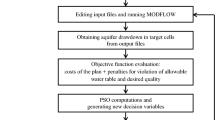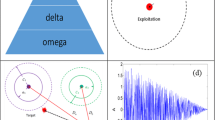Abstract
Multi-objective optimization problems can be solved through Simulation-Optimization (S-O) techniques where the pareto front gives the optimal solutions in the problem domains. During the selection of different modelling methods, optimization techniques and management scenarios, several pareto fronts can be generated. In the present work, an attempt has been made by performing intensive comparisons between different pareto fronts to compare the efficiency and convergence of different S-O models. In this process, groundwater models were developed to simulate the River-Aquifer (R-A) exchanges for the study area as groundwater pumping influences the rate of R-A exchanges and alters the flow dynamics. The developed models were coupled with optimization models and were executed to solve the multi-objective optimization problems based on the maximization of discharge through pumping wells and maximization of groundwater input into the river through R-A exchanges. The distinctive features of the paper include a pareto front comparison where fronts developed by different S-O models were compared and analysed based on various parameters. The results show the dominance of Multi-Objective Particle Swarm Optimization (MOPSO) over other optimization algorithms and concluded that the maximization of pumping rate significantly changes after considering the R-A exchanges-based objective functions. This study concludes that the model domain also alters the output of simulation–optimization. Therefore, model domain and corresponding boundary conditions should be selected carefully for the field application of management models. The artificial neural network (ANN) models have been also developed to deal with the computationally expensive simulation models by reducing the processing time and found efficient.





Similar content being viewed by others
References
Abd-Elmaboud M, Abdelgawad HAA, El-Alfy K, Ezzeldin M (2021) Estimation of groundwater recharge using simulation-optimization model and cascade forward ANN at East Nile Delta aquifer, Egypt. J Hydrol Reg Stud 34. https://doi.org/10.1016/j.ejrh.2021.100784
Anderson MP (2005) Heat as a ground water Tracer. Ground Water 43(6):951–968
Asadzadeh M, Tolson BA, Burn DH (2014) A new selection metric for multiobjective hydrologic model calibration. Water Resour Res 50(9):7082–7099
Atwell BH, MacDonald RB, Bartolucci LA (1971) Thermal mapping of streams from airborne radiometric scanning. Water Resour Bull 7(2):228–243
Audet C, Bigeon J, Cartier D, Le Digabel S, Salomon L (2020) Performance indicators in multiobjective optimization. Eur J Oper Res 292. https://doi.org/10.1016/j.ejor.2020.11.016
Auger A, Bader J, Brockhoff D, Zitzler E (2009) Theory of the hypervolume indicator: optimal μ-distributions and the choice of the reference point. In Proceedings of the tenth ACM SIGEVO Workshop on Foundations of genetic algorithms, 87–102
Avent B, González J, Diethe T, Paleyes A, Balle B (2020) Automatic discovery of privacy-utility pareto fronts. Proc Priv Enh Technol 2020(4):5–23
Bassi M, Cursi ESD, Pagnacco E, Ellaia R (2018) Statistics of the Pareto front in Multi-objective Optimization under Uncertainties. Lat Am J Solids Struct 15:11
Becker MW, Georgian T, Ambrose H, Siniscalchi J, Fredrick K (2004) Estimating flow and flux of groundwater discharge using water temperature and velocity. J Hydrol 296(1–4):221–233
Belakaria S, Deshwal A (2019) Max-value entropy search for multi-objective bayesian optimization. In International Conference on Neural Information Processing Systems (NeurIPS)
Binois M, Ginsbourger D, Roustant O (2015) Quantifying uncertainty on Pareto fronts with Gaussian process conditional simulations. Eur J Oper Res 243(2):386–394
Burkholder BK, Grant GE, Haggerty R, Khangaonkar T, Wamper PJ (2008) Influence of hyporheic flow and geomorphology on the temperature of a large, gravel-bed River, Clackamas River, Oregon, USA. Hydrol Process 22:941–953
Calandra R, Peters J, Deisenrothy MP (2014) Pareto front modelling for sensitivity analysis in multi-objective bayesian optimization. In NIPS Workshop on Bayesian Optimization, vol 5
Cao P, Fan Z, Gao R, Tang J (2017) A manufacturing-oriented single point search hyper-heuristic scheme for multi-objective optimization. In ASME 2017 International Design Engineering Technical Conferences and Computers and Information in Engineering Conference. American Society of Mechanical Engineers Digital Collection
Coello CAC, Pulido GT, Lechuga MS (2004) Handling multiple objectives with particle swarm optimization. IEEE Trans Evol Comput 8(3):256–279
Conant B, Robinson CE, Hinton MJ, Russell HAJ (2019). A framework for conceptualizing groundwater-surface water interactions and identifying potential impacts on water quality, water quantity, and ecosystems. J Hydrol 574:609–627
Constantz J (1998) Interaction between stream temperature, streamflow, and groundwater exchanges in alpine streams. Water Resour Res 34:1609–1615
Cristea NC, Burges SJ (2009) Use of thermal infrared imagery to complement monitoring and modeling of spatial stream temperature. J Hydrol Eng 14(10):1080–1090
Dangar S, Asoka A, Mishra V (2021) Causes and implications of groundwater depletion in India: A review. J Hydrol. https://doi.org/10.1016/j.jhydrol.2021.126103
Deb K (2001) Multi-objective optimization using evolutionary algorithms. John Wiley & Sons, Ltd, Chichester, England
Emmerich MTM, Deutz AH (2018) A tutorial on multiobjective optimization: fundamentals and evolutionary methods. Nat Comput 17(3):585–609
Etsias G, Katsifarakis KL (2017) Combining pumping flowrate maximization from polluted aquifers with cost minimization. Environ Process 4:991–1012
Gomo M (2011) A groundwater-surface water interaction study of an alluvial channel aquifer. Doctoral dissertation, Institute for Groundwater Studies - University of the Free State, South Africa
Handcock RN, Gillespie AR, Cherkauer KA, Kay JE, Burges SJ, Kampf SK (2006) Accuracy and uncertainty of thermal infrared remote sensing of stream temperatures at multiple spatial scales. Remote Sens Environ 100:427–440
Hebert C, Caissie D, Satish MG, El-Jabi N (2011) Study of stream temperature dynamics and corresponding heat fluxes within Miramichi River catchments (New Brunswick, Canada). Hydrol Process 25:2439–2455
Hernández-Lobato D, Hernandez-Lobato J, Shah A, Adams R (2016) Predictive entropy search for multi-objective bayesian optimization. In International Conference on Machine Learning, pp 1492–1501. PMLR
Höllermann B, Evers M (2019) Coping with uncertainty in water management: Qualitative system analysis as a vehicle to visualize the plurality of practitioners’ uncertainty handling routines. J Environ Manage 235:213–223
Horn D, Demircioğlu A, Bischl B et al (2018) A comparative study on large-scale kernelized support vector machines. Adv Data Anal Classif 12:867–883
Jha MK, Peralta RC et al (2020) Simulation-optimization for conjunctive water resources management and optimal crop planning in Kushabhadra-Bhargavi river delta of Eastern India. Int J Environ Res Public Health 17(10):3521
Kalbus E, Reinstorf F, Schirmer M (2006) Estimating flow and flux of groundwater discharge using water temperature and velocity. Hydrol Earth Syst Sci 10:873–887
Kay JE, Kampf SK, Handcock RN, Cherkauer KA, Gillespie AR, Burges SJ (2005) Accuracy of lake and stream temperatures estimated from thermal infrared images. J Am Water Resour Assoc 41:1161–1175
Keery J, Binley A, Crook N, Smith JWN (2007) Temporal and spatial variability of groundwater-surface water fluxes: Development and application of an analytical method using temperature time series. J Hydrol 336:1–16
Kollat JB, Reed PM (2005) The value of online adaptive search: a performance comparison of NSGAII, ε-NSGAII, and εMOEA. International Conference on Evolutionary Multi-Criterion Optimization. Springer, Berlin, Heidelberg
Li Y-F, Ng S, Xie M, Goh T (2010) A systematic comparison of metamodeling techniques for simulation optimization in Decision Support Systems. Appl Comput 10:1257–1273. https://doi.org/10.1016/j.asoc.2009.11.034
Loheide SP, Gorelick SM (2006) Quantifying stream – aquifer interactions through the analysis of remotely sensed thermographic profiles and in situ temperature histories. Environ Sci Technol 40(10):3336–3341
Lowry CS, Walker JF, Hunt RJ, Anderson MP (2007) Identifying spatial variability of groundwater discharge in a wetland stream using a distributed temperature sensor. Water Resour Res 43:W10408
Mao W, Yang J, Zhu Y, Ye M, Jingwei Wu (2017) Loosely coupled SaltMod for simulating groundwater and salt dynamics under well-canal conjunctive irrigation in semi-arid areas. Agric Water Manag 192:209–220
Marjit R, Hopfe CJ (2009) Multi-objective robust optimization algorithms for improving energy consumption and thermal comfort of buildings
Martínez-Cagigal V (2020) Multi-objective particle swarm optimization (MOPSO). MATLAB Central File Exchange 5–14
McDonald MG, Harbaugh AW (1988) A modular three-dimensional finite-difference ground-water flow model, 6. U.S. Geological Survey Techniques of Water-Resources Investigations
Paran F, Arthaud F, Bornette G, Graillot D, Lalot E, Marmonier P, Novel M, Piscart C (2012) Characterization of exchanges between Rhône River and groundwater., Research report ZABR Phase 4, AERMC
Riquelme N, Von Lücken C, Baran B (2015) Performance metrics in multi-objective optimization. Latin American Computing Conference (CLEI). IEEE
Salomon L, Audet C, Bigeon J, Le Digabel S (2018) Review of the quality of approximated Pareto fronts in multiobjective optimization. JOpt
Sophocleous M (2002) Interactions between groundwater and surface water: the state of the science. Hydrogeol J 10:52–67
Tigkas D, Christelis V, Tsakiris G (2016) Comparative study of evolutionary algorithms for the automatic calibration of the Medbasin-D conceptual hydrological model. Environ Process 3:629–644
Wawrzyniak V, Piégay H, Poirel A (2012) Longitudinal and temporal thermal patterns of the French Rhône River using Landsat ETM+ thermal infrared images. Aquat Sci 74(3):405–414
Westhoff MC, Savenije HHG, Luxemburg WMJ, Stelling GS, van de Giesen NC, Selker JS, Pfister L, Uhlenbrook S (2007) A distributed stream temperature model using high resolution temperature observations. Hydrol Earth Syst Sci 11:1469–1480
Zhang Q, Li H (2007) MOEA/D: A multiobjective evolutionary algorithm based on decomposition. IEEE Trans Evol Comput 11(6):712–731
Zitzler E, Thiele L, Laumanns M, Fonseca CM, da Fonseca VG (2003) Performance assessment of multiobjective optimizers: An analysis and review. IEEE Trans Evol Comput 7(2):117–132
Author information
Authors and Affiliations
Contributions
All authors contributed to the study conception and design. Material preparation, data collection and analysis were performed by Mayank Bajpai and Shreyansh Mishra. The first draft of the manuscript was written by Shreyansh Mishra while Dr Shishir gaur finalized the draft. All authors commented on previous versions of the manuscript. All authors read and approved the final manuscript.
Corresponding author
Ethics declarations
Competing Interest
The authors have no conflicts of interest to declare that are relevant to the content of the article.
Additional information
Publisher's Note
Springer Nature remains neutral with regard to jurisdictional claims in published maps and institutional affiliations.
Rights and permissions
About this article
Cite this article
Bajpai, M., Mishra, S., Gaur, S. et al. Optimization of Groundwater Pumping and River-Aquifer Exchanges for Management of Water Resources. Water Resour Manage 36, 1863–1878 (2022). https://doi.org/10.1007/s11269-022-03112-5
Received:
Accepted:
Published:
Issue Date:
DOI: https://doi.org/10.1007/s11269-022-03112-5




